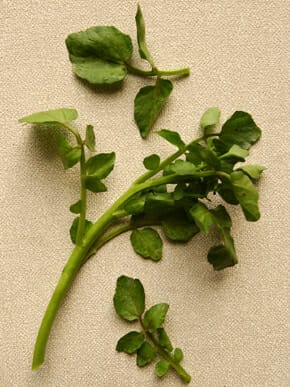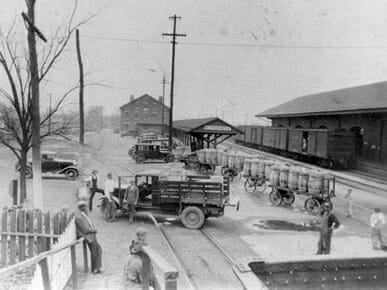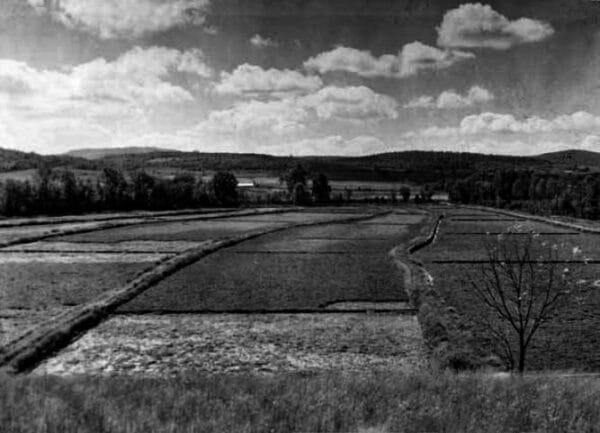Watercress Production
Although never a major cash crop, watercress was an important commodity in Alabama during the first half of the twentieth century. The watercress industry was centered in Madison County, then known primarily for its textiles and cotton, but at the height of production, the area also was known as the “Watercress Capital of the World.” From the early twentieth century through the 1960s, more than 2 million bunches of watercress were grown and harvested in the area, more than produced by any other source in the United States. Today, watercress production continues in Madison County, but on a much-reduced scale.
 Watercress
Found throughout Europe, Asia, and the Americas, watercress is in the same family as the popular garden flower nasturtium, which is also edible. Watercress grows along streams, in ponds, and in damp soils and prefers a cool, shady environment. With its mild climate, abundant streams, and chalky soil, north Alabama is ideal for growing watercress. Watercress is used most often as a peppery garnish and salad component, but it also has been touted as a health food and a medicine. Long used to stave off scurvy for its high vitamin C content, watercress may also help inhibit tobacco-related cancers and other lung diseases. In addition to vitamin C, the plant is rich in vitamins A, B, and E and also contains both calcium and iron. Considered a traditional Southern treat, watercress is used in sauces, sandwiches, soups, salads, stuffing, breads, vegetables, and main dishes.
Watercress
Found throughout Europe, Asia, and the Americas, watercress is in the same family as the popular garden flower nasturtium, which is also edible. Watercress grows along streams, in ponds, and in damp soils and prefers a cool, shady environment. With its mild climate, abundant streams, and chalky soil, north Alabama is ideal for growing watercress. Watercress is used most often as a peppery garnish and salad component, but it also has been touted as a health food and a medicine. Long used to stave off scurvy for its high vitamin C content, watercress may also help inhibit tobacco-related cancers and other lung diseases. In addition to vitamin C, the plant is rich in vitamins A, B, and E and also contains both calcium and iron. Considered a traditional Southern treat, watercress is used in sauces, sandwiches, soups, salads, stuffing, breads, vegetables, and main dishes.
In 1874, Frank Dennis, as a young entrepreneur, had begun supplying wild watercress to restaurants and hotels around his home in West Long Branch, New Jersey. Demand was so great that his business grew to include a network of farms in Pennsylvania, Maryland, Virginia, and West Virginia. Harsh winters, however, limited production. Through an acquaintance with a farm family in Madison County, Dennis discovered that north Alabama was an ideal area for producing watercress during the winter. So in 1908 Dennis bought and leased a series of ponds and dammed streams in Madison County. The Dennis family maintained a large farm in Martin, West Virginia, as its main office, but Huntsville quickly became the winter headquarters from December to May. Dennis cultivated several varieties of watercress, referred to as Winter, Early Spring, and Late Spring, to maximize production.
During the early years of the Alabama operation, the watercress was grown in shallow ponds and harvested by field workers every four to six weeks. The plants were then tied in bunches and delivered in tubs to a facility where the plants were washed and cooled. At the packing house, the watercress was placed with ice in barrels and shipped by rail to terminal markets and restaurants in Chicago, New Orleans, and New York. The Dennis company owned and operated both the processing and packing facilities near the Huntsville Depot.
 Watercress at Huntsville Freight Depot, ca. 1920s
When Dennis died in 1922, his son Charles Edward Dennis took over the business and became a leading authority on watercress, earning the nickname the “Water Cress King.” He had a keen interest in watercress culture and introduced several innovations, including shipping the plants in smaller custom-made wooden boxes lined with parchment. Shippers were thus able to deliver these smaller boxes of watercress quickly and cheaply to every state east of the Rockies. He also developed promotional items that advertised the business, including matchbooks, playing cards, wildlife calendars, and recipe books printed with the Dennis logo. Prior to Charles Dennis’s death in 1951, the business was incorporated and continued under family control.
Watercress at Huntsville Freight Depot, ca. 1920s
When Dennis died in 1922, his son Charles Edward Dennis took over the business and became a leading authority on watercress, earning the nickname the “Water Cress King.” He had a keen interest in watercress culture and introduced several innovations, including shipping the plants in smaller custom-made wooden boxes lined with parchment. Shippers were thus able to deliver these smaller boxes of watercress quickly and cheaply to every state east of the Rockies. He also developed promotional items that advertised the business, including matchbooks, playing cards, wildlife calendars, and recipe books printed with the Dennis logo. Prior to Charles Dennis’s death in 1951, the business was incorporated and continued under family control.
Dennis Water Cress, a wholesale business, sold to approximately 750 customers, including commissioned merchants, hotels, restaurants, and steamship and railway companies. Dennis watercress became so widespread that it was even served at the White House. Dennis’s biggest breakthrough in expanding its business came during World War II, when watercress earned a place on the Department of Defense Procurement List, which provided guidelines for required items in military commissaries. Grocery stores and supermarkets quickly joined the supply chain. At its peak in the 1950s, the Huntsville branch had expanded to 50 acres of ponds under cultivation and employed as many as 40 people. The Dennis company operated more than 100 acres of watercress ponds in total in the eastern United States.
 Watercress Pond in Madison County
The following decade saw a decline in the business. After a bitter lawsuit that dragged on for several years during the 1960s over the poor quality of shipped watercress, Railway Express discontinued shipments of Dennis watercress. Inflation and a series of harsh winters also contributed to the company’s move, in 1969, to South Florida to take advantage of a milder climate and better transportation. Most of the ponds in Madison County were sold at this time, except for an area in New Market, which remained successful. The springs there generated 20 million gallons of water per day at an ideal temperature of 68 degrees. In 1973, nearly a century after Frank Dennis began selling wild watercress, the company was taken over by a rival company, B&W Quality Growers, a Florida-based company, owned by Richard Burgoon. His nephew Robert Burgoon now runs the New Market operation.
Watercress Pond in Madison County
The following decade saw a decline in the business. After a bitter lawsuit that dragged on for several years during the 1960s over the poor quality of shipped watercress, Railway Express discontinued shipments of Dennis watercress. Inflation and a series of harsh winters also contributed to the company’s move, in 1969, to South Florida to take advantage of a milder climate and better transportation. Most of the ponds in Madison County were sold at this time, except for an area in New Market, which remained successful. The springs there generated 20 million gallons of water per day at an ideal temperature of 68 degrees. In 1973, nearly a century after Frank Dennis began selling wild watercress, the company was taken over by a rival company, B&W Quality Growers, a Florida-based company, owned by Richard Burgoon. His nephew Robert Burgoon now runs the New Market operation.
Important changes have occurred in the transportation and marketing of watercress in the United States. In 1950, during the heyday of Dennis Water Cress and railroad transportation, terminal markets such as New York, Chicago, and New Orleans comprised 70 percent of the distribution. Sales staffs were located at each of these main hubs. By contrast, in 1990, only 20 percent of watercress was shipped to terminal markets. Now it is more efficient for refrigerated express trucks to deliver direct to dealers and marketplaces. Today, watercress from ponds in New Market is shipped via airfreight to international markets that include England, France, Canada, South America, and the Caribbean.
Additional Resources
Lang, Christopher. “Dennis Water Cress in Huntsville.” Alabama Heritage 66 (Fall 2002): 44-48.
———. “Dennis Water Cress.” In Cornbread Nation 4, the Best of Southern Food Writing, edited by Dale Volberg Reed and John Shelton Reed. Athens: University of Georgia Press, 2008.
———. “The Huntsville Depot and Dennis Watercress.” Huntsville Historical Review 31 (Winter-Spring 2006): 34-50.



